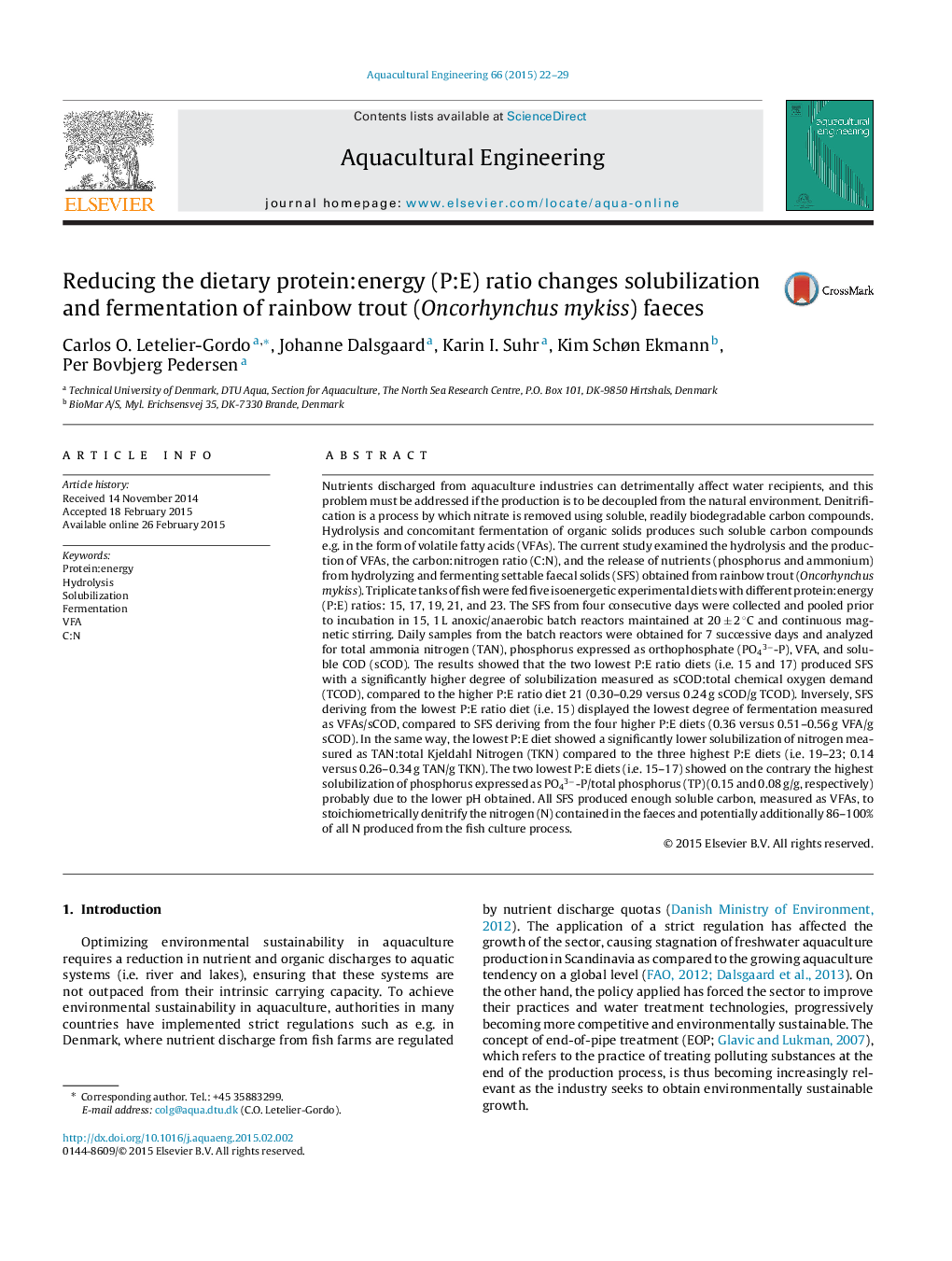| کد مقاله | کد نشریه | سال انتشار | مقاله انگلیسی | نسخه تمام متن |
|---|---|---|---|---|
| 4527179 | 1625704 | 2015 | 8 صفحه PDF | دانلود رایگان |

• Hydrolysis, production of VFAs, carbon:nitrogen ratio (C:N), release of nutrients (phosphorus and ammonium) were examined from hydrolyzing and fermenting settable faecal solids (SFS) obtained from nutrient mass balance system containing rainbow trout (Oncorhynchus mykiss).
• The two lowest P:E ratio diets produced SFS with a significantly higher degree of solubilization measured as sCOD:total chemical oxygen demand (TCOD).
• SFS deriving from the lowest P:E ratio diet displayed the lowest degree of fermentation measured as VFAs/sCOD.
• The lowest P:E diet showed a significantly lower solubilization of TAN measured as TAN:total Kjeldahl Nitrogen (TKN) compared to the three highest P:E diets.
• All SFS produced enough soluble carbon, measured as VFAs, to apparently denitrify the nitrogen (N) contained in the faeces and potentially an additionally 86–100% of all N produced from the fish culture process.
Nutrients discharged from aquaculture industries can detrimentally affect water recipients, and this problem must be addressed if the production is to be decoupled from the natural environment. Denitrification is a process by which nitrate is removed using soluble, readily biodegradable carbon compounds. Hydrolysis and concomitant fermentation of organic solids produces such soluble carbon compounds e.g. in the form of volatile fatty acids (VFAs). The current study examined the hydrolysis and the production of VFAs, the carbon:nitrogen ratio (C:N), and the release of nutrients (phosphorus and ammonium) from hydrolyzing and fermenting settable faecal solids (SFS) obtained from rainbow trout (Oncorhynchus mykiss). Triplicate tanks of fish were fed five isoenergetic experimental diets with different protein:energy (P:E) ratios: 15, 17, 19, 21, and 23. The SFS from four consecutive days were collected and pooled prior to incubation in 15, 1 L anoxic/anaerobic batch reactors maintained at 20 ± 2 °C and continuous magnetic stirring. Daily samples from the batch reactors were obtained for 7 successive days and analyzed for total ammonia nitrogen (TAN), phosphorus expressed as orthophosphate (PO43−-P), VFA, and soluble COD (sCOD). The results showed that the two lowest P:E ratio diets (i.e. 15 and 17) produced SFS with a significantly higher degree of solubilization measured as sCOD:total chemical oxygen demand (TCOD), compared to the higher P:E ratio diet 21 (0.30–0.29 versus 0.24 g sCOD/g TCOD). Inversely, SFS deriving from the lowest P:E ratio diet (i.e. 15) displayed the lowest degree of fermentation measured as VFAs/sCOD, compared to SFS deriving from the four higher P:E diets (0.36 versus 0.51–0.56 g VFA/g sCOD). In the same way, the lowest P:E diet showed a significantly lower solubilization of nitrogen measured as TAN:total Kjeldahl Nitrogen (TKN) compared to the three highest P:E diets (i.e. 19–23; 0.14 versus 0.26–0.34 g TAN/g TKN). The two lowest P:E diets (i.e. 15–17) showed on the contrary the highest solubilization of phosphorus expressed as PO43−-P/total phosphorus (TP) (0.15 and 0.08 g/g, respectively) probably due to the lower pH obtained. All SFS produced enough soluble carbon, measured as VFAs, to stoichiometrically denitrify the nitrogen (N) contained in the faeces and potentially additionally 86–100% of all N produced from the fish culture process.
Journal: Aquacultural Engineering - Volume 66, May 2015, Pages 22–29